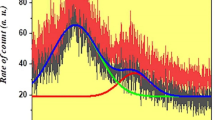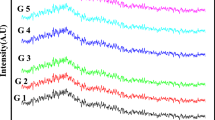Abstract
In this work, the multivalent transition metal oxide, Cu2O3, has been added in different content to the primary constituents of the Ca/Na lead Arseborate oxide glass. These required glasses were created using the fast-quenching method using the chemical formula: {50 wt% Na2B4O7.10 H2O–17 wt% CaO–17.5 wt% PbO–17.5 wt% As2O3} − x Cu2O3 where x = 0, 0.25, 0.5, 0.75, and 1g. Utilizing X-ray diffraction (XRD) patterns, electron spin resonance absorption (ESR), and Fourier transform infrared (FTIR) spectra, the interior structures of the prepared solids have been examined. Both XRD patterns and FTIR charts clarified that the amount of Cu2O3, in the range of 0–1g, did not affect the amorphous nature of Ca/Na lead-based Arseborate oxide glass, with the existence of four fundamental building units in each sample (BO3, BO4, PbO4, and AsO4). According to the optical characterization using UV–vis spectra, the increase in Cu2O3 concentration led to a decrease in optical energy gaps while increasing optical absorbance, optical reflectance, the plasmon frequency, calculated linear and nonlinear refractive indices, optical conductivity, and optoelectric conductivities. The results of the calculations and radioactive measurements indicated that the effective mass number increased as the amount of Cu2O3 content was increased, while the mean free path MFP and the half-value layer HVL decreased. According to the results, the examined glasses can be used as IR filters and shields.


















Similar content being viewed by others
Data availability
All the original measurements and data analysis of this work will be available when required.
References
Aboud, H., Wagiran, H., Hussin, R., Ali, H., Alajerami, Y., Saeed, M.A.: Thermoluminescence properties of the Cu-doped lithium potassium borate glass. Appl. Rad. Isot. 90, 35–39 (2014). https://doi.org/10.1016/j.apradiso.2014.01.012
Abouhaswa, A.S., Tekin, H.O., Ahmed, E.M., Kilicoglu, O., Rammah, Y.S.: Synthesis, physical, linear optical and nuclear radiation shielding characteristics of B2O3–BaO–PbO–SrO2 glasses. J. Mater. Sci. Mater. Electron. 32, 18163–18177 (2021). https://doi.org/10.1007/s10854-021-06359-7
Agar, O., Kavaz, E., Altunsoy, E.E., Kilicoglu, O., Tekin, H.O., Sayyed, M.I., Erguzel, T.T., Tarhan, N.: Er2O3 effects on photon and neutron shielding properties of TeO2–Li2O–ZnO–Nb2O5 glass system. Results Phys. 13, 17–24 (2019). https://doi.org/10.1016/j.rinp.2019.102277
Al-Buriahi, M.S., Sriwunkum, C., Arslan, H., et al.: Investigation of barium borate glasses for radiation shielding applications. Appl. Phys. A 126, 68 (2020). https://doi.org/10.1007/s00339-019-3254-9
Alharbi, S.R., Qasrawi, A.F.: Effects of Au nanoslabs on the performance of CdO thin films designed for optoelectronic applications. Physica E 125(2020), 114386 (2021). https://doi.org/10.1016/j.physe.2020.114386
Arumanayagam, T., Murugakoothan, P.: Optical conductivity and dielectric response of an organic aminopyridine NLO single crystal. In J. Min. Mater. Charact. Eng. 10(13), 1225–1231 (2011). https://doi.org/10.4236/jmmce.2011.1013095
Aşkın, A., Dal, M.: Investigation of the gamma ray shielding behaviour of (90–x)TeO2—xMoO3—10ZnO glass system using geant4 simulation code and WinXCOM database. Cumhur. Sci. J. 40, 738–748 (2019). https://doi.org/10.17776/csj.560193
Balachander, L., Ramadevudu, G., Shareefuddin, M., Sayanna, R., Venudhar, Y.C.: IR analysis of borate glasses containing three alkali oxides. ScienceAsia 39(2), 278–283 (2013)
Bishay, A.M., Arafa, S.: Gamma-induced absorption and structural studies of arsenic borate glasses. J. Am. Ceram. Soc. 49, 423–430 (1966). https://doi.org/10.1111/j.1151-2916.1966.tb15409.x
Ciceo-Lucacel, R., Ardelean, I.: FT-IR and Raman study of silver lead borate-based glasses. J. Non-Cryst. Solids 353(18–21), 2020–2024 (2007). https://doi.org/10.1016/j.jnoncrysol.2007.01.066
Do Nascimento, P.C., Bohrer, D., Becker, E., de Carvalho, L.M.: Comparison of different sample treatments for arsenic speciation in glass samples. J. Non Cryst. Solids 351(14–15), 1312–1316 (2005). https://doi.org/10.1016/j.jnoncrysol.2005.03
Dresselhaus, M.S., Cronin, S.B.: Graduate texts in physics solid state properties. Springer, Berlin (2018)
Edukondalu, A., Purnima, M., Srinivasy, C., Sripathi, T., Awasthi, A.M., Rahman, S., Kumar, K.S.: Mixed alkali effect in physical and optical properties of Li2O–Na2O–WO3–B2O3 glasses. J. Non-Cryst. Solids 358(18–19), 2581–2588 (2012). https://doi.org/10.1016/j.jnoncrysol.2012.06
Elkatlawy, S.M., Abdel-Ghany, A.M., Yahia, I.S., Abd El-Ghany, H.A., Gomaa, H.M.: Structure–property relationship and spectroscopic studies of BaO–B2O3 oxide glasses containing ZnO for optical applications. Boletín De La Sociedad Española De Cerámica y Vidrio (2021). https://doi.org/10.1016/j.bsecv.2021.08.003
El-Khayatt, A.M., Saudy, H.A.: Preparation and characterization of zinc, lanthanum white sand glass for use in nuclear applications. Radiat. Phys. Chem. 166, 108497 (2020). https://doi.org/10.1016/j.radphyschem.2019.108497
El-Mansy, M.K., Gomaa, H.M., Hendawy, N., Sabry Morsy, A.: Effect of exchange of Bi+3 b y Nb+5 on the structural and optical properties of some (BBiNb)2 O7 CaO oxide glasses. J. Non-Cryst. Solids 485, 42–46 (2018). https://doi.org/10.1016/j.jnoncrysol.2018.01.036
Garawi, M.: Precise assessment of gamma absorbed dose rates using different techniques. Arab. J. Nucl. Sci. Appl. (2018). https://doi.org/10.21608/ajnsa.2018.2415.1031
Gerward, L., Guilbert, N., Jensen, K.B., Levring, H.: WinXCom—A program for calculating X-ray attenuation coefficients. Radiat. Phys. Chem. (2004). https://doi.org/10.1016/j.radphyschem.2004.04.040
Gomaa, H.M., El-Dosokey, A.H.: FTIR analysis & dielectric constant for some iron bismuth borate glasses. Drug Des. Intellect. Prop. Int. J. 2(3), 211–214 (2018)
Gomaa, H.M., Yahia, I.S.: Toward a novel and accurate relationship between electrical and optical conductivity in opto-material sciences: New strategy. J. Comput. Electron. (2022a). https://doi.org/10.1007/s10825-022-01943-4
Gomaa, H.M., Yahia, I.S.: A new strategy: a more valid determination of the nonlinear optical parameters for optoelectronic applications. J. Comput. Electron. 21, 1174–1179 (2022b). https://doi.org/10.1007/s10825-022-01915-8
Gomaa, H.M., Sayyed, M.I., Tekin, H.O., Lakshminarayana, G., El-Dosokey, A.H.: Correlate the structural changes to gamma radiation shielding performance evaluation for some calcium bismuth-borate glasses containing Nb2O5. Phys. B Condens. Matter 567, 109–112 (2019). https://doi.org/10.1016/j.physb.2018.11.011
Gomaa, H.M., Saudi, H.A., Yahia, I.S., et al.: Impact of graphite impurities on the structure and optical properties of the sodium borate oxide glass. J. Mater. Sci. Mater. Electron. 32, 27553–27563 (2021a). https://doi.org/10.1007/s10854-021-07130-8
Gomaa, H.M., Yahia, I.S., Makram, B.M.A., et al.: Optical and structural studies of some zinc calcium borate glasses for optoelectronic device applications. J. Mater. Sci. Mater. Electron. 32, 9392–9399 (2021b). https://doi.org/10.1007/s10854-021-05602-5
Gomaa, H.M., Abul-Magd, A.A., Abu-Khadra, A.S., Yahia, I.S., Zahran, H.Y.: Structural, and optical characterizations of Cu/Fe@Na2B4O7 oxide glass: for shielding and optical applications. Optik 261, 169170 (2022a). https://doi.org/10.1016/j.ijleo.2022.169170
Gomaa, H.M., Saudi, H.A., Yahia, I.S., Ibrahim, M.A., Zahran, H.Y.: Influence of exchanging CeO2 with Cu2O3 on structural matrix, shielding, and linear/nonlinear optical parameters of the cerium-sodium borate glass. Optik 249, 168267 (2022b). https://doi.org/10.1016/j.ijleo.2021.168267
Gomaa, H.M., Yahia, I.S., Zahren, H.Y., Saudi, H.A., El-Dosokey, A.H.: Effect of replacement of SiO2 with BaTiO3 on the cadmium calcium-borate glass: Aiming to obtain an active glass for optical and shielding applications. Rad. Phys. Chem. 193, 109955 (2022e). https://doi.org/10.1016/j.radphyschem.2021.109955
Gomaa, H.M., Yahia, I.S., Yousef, E.S., et al.: A novel correction method toward extraction of reflectance and linear refractive index of some borosilicate glasses doped with BaTiO3. J. Electron. Mater. 51, 6347–6355 (2022f). https://doi.org/10.1007/s11664-022-09858-3
Górny, A., Kuwik, M., Pisarski, W.A., Pisarska, J.: Lead borate glasses and glass-ceramics singly doped with Dy3+ for White LEDs. Materials 13(21), E5022 (2022). https://doi.org/10.3390/ma13215022.PMID:33171744;PMCID:PMC7664324
Günoğlu, K.: The mass attenuation coefficients, effective atomic numbers and effective electron numbers of some concrete containing barite for 511, 835 and 1275 keV gamma rays. Euro. J. Sci. Technol. (2018). https://doi.org/10.31590/ejosat.453665
Hemminga, M.A., Berliner, L.J., Štrancar, J.: Advanced ESR Spectroscopy in Membrane Biophysics. In: Hemminga, M.A., Berliner, L.J. (eds.) ESR spectroscopy in membrane. Biophysics biological magnetic resonance, vol. 27. Springer, Boston (2007). https://doi.org/10.1007/978-0-387-49367-1_3
Issa, S.A.M., Susoy, G., Ali, A.M., Tekin, H.O., Saddeek, Y.B., Al-Hajry, A., Algarni, H., Anjana, P.S., Agar, O.: The effective role of La2O3 contribution on zinc borate glasses: radiation shielding and mechanical properties. Appl. Phys. A Mater. Sci. Process. 125, 1–19 (2019). https://doi.org/10.1007/s00339-019-3169-5
Itoh, S., Yamashita, H., Maekawa, T.: Differential pulse voltammetry of tin ion doped Na2O-CaO-SiO2 Glass Melts. J. Ceram. Soc. Japan. 112(2), 110–113 (2004). https://doi.org/10.2109/jcersj.112.110
Kamil, S.M., Gomaa, H.M., El-Gammal, W., et al.: Effect of exchanging PbO with NiO on the structure and optical parameters action of some lanthanum borate oxide glasses. J. Mater. Sci. Mater. Electron. 32, 24168–24175 (2021). https://doi.org/10.1007/s10854-021-06882-7
Kaur, S., Singh, K.J.: Investigation of lead borate glasses doped with aluminium oxide as gamma ray shielding materials. Ann. Nuclear Energy 63, 350–354 (2014). https://doi.org/10.1016/j.anucene.2013.08.012
Monajjemi, M., Mollaamin, F., Najaflou, N., et al.: Physical chemistry study of graphite liquid exfoliation through (π–π) interaction by (n)-annulene. Russ. J. Phys. Chem. 96, 2222–2231 (2022). https://doi.org/10.1134/S0036024422100247
Mostafa, A.G., Hassan, M.Y., Goumaa, H.M.: DSC thermal analysis for some calcium iron Arsi-vanadate oxide glasses. Org. Med. Chem. i. J. 6(4), 555693 (2018). https://doi.org/10.19080/OMCIJ.2018.06.555693
Pilbrow, J.R.: Transition ion electron paramagnetic resonance. Clarendon Press, Oxford (1990). https://doi.org/10.1002/bbpc.19910951036
Pisarski, W.A., Pisarska, J., Dominiak-Dzik, G., Mączka, M., Ryba-Romanowski, W.: Compositional-dependent lead borate based glasses doped with Eu3+ ions: synthesis and spectroscopic properties. J. Phys. Chem. Solids 67(12), 2452–2457 (2006)
Qasrawi, A.F., Alharbi, S.R.: Enhancing the optoelectronic performance of As2Se3 thin films via Ag slabs sandwiching. Optik 219, 165228 (2020). https://doi.org/10.1016/j.ijleo.2020.165228
Qasrawi, A.F., Hamarsheh, A.A.: Band offsets, electron affinities and optical dynamics at the CdBr2/SiO2 interfaces. Optik 243, 1–8 (2021). https://doi.org/10.1016/j.ijleo.2021.167467
Qasrawi, A.F., Omareya, O.A.: Formation and characterization of Cd2 S3 polycrystalline films onto glass and lanthanum substrates. J. Electron. Mater. 48(4), 2350–2355 (2019). https://doi.org/10.1007/s11664-018-06905-w
Raghavaiah, B.V., Veeraiah, N.: The role of As2O3 on the stability and some physical properties of PbO–Sb2O3 glasses. J. Phys. Chem. Solids 65(6), 1153–1164 (2004). https://doi.org/10.1016/j.jpcs.2004.01.004
Sayyed, M.I., Issa, S.A.M., Tekin, H.O., Saddeek, Y.B.: Comparative study of gamma-ray shielding and elastic properties of BaO–Bi2O3–B2O3 and ZnO–Bi2O3–B2O3 glass systems. Mater. Chem. Phys. (2018). https://doi.org/10.1016/j.matchemphys.2018.06.034
Srinivasarao, G., Veeraiah, N.: Influence of Cr3 ions on the structure and certain physical properties of PbO-As2O3 glasses. Eur. Phys. J. Appl. Phys. 16(1), 11–22 (2001). https://doi.org/10.1051/epjap:2001188
Thakuria, R., Nath, N.K., Saha, B.K.: The nature and applications of π–π interactions: a perspective. Cryst. Growth Des. 19(2), 523–528 (2019). https://doi.org/10.1021/acs.cgd.8b01630
Wright, J.R., Hendrickson, W.A., Osaki, S., James, G.T.: Electron spin resonance spectroscopy (Esr). In: Wright, J.R., Hendrickson, W.A., Osaki, S., James, G.T. (eds.) Physical methods for inorganic. Biochemistry biochemistry of the elements, vol. 5. Springer, Boston (1986). https://doi.org/10.1007/978-1-4684-4997-6_5
Funding
The authors extend their appreciation to the Ministry of Education in KSA for funding this research work through project number KKU-IFP3-DB-1.
Author information
Authors and Affiliations
Contributions
HMG and HAS suggested the research idea, performed all calculations, measurements, data analysis, and wrote the section of results and discussion. HYZ and ISY review the manuscript, and funded the samples preparation as well as the experimental measurements.
Corresponding author
Ethics declarations
Conflict of interest
Authors confirm that there is no Conflict of Interest about this work with anybody.
Ethical approval
This article doesn't contain any studies involving animals performed by any authors. Also, this article does not have any studies involving human participants performed by any of the authors.
Additional information
Publisher's Note
Springer Nature remains neutral with regard to jurisdictional claims in published maps and institutional affiliations.
Rights and permissions
Springer Nature or its licensor (e.g. a society or other partner) holds exclusive rights to this article under a publishing agreement with the author(s) or other rightsholder(s); author self-archiving of the accepted manuscript version of this article is solely governed by the terms of such publishing agreement and applicable law.
About this article
Cite this article
Gomaa, H.M., Saudi, H.A., Yahia, I.S. et al. Role of low-concentrated Cu2O3 additives in changing the structural internal phase, optical property, and radiation gamma-ray shielding ability of Ca/Na lead Arseborate glass. Opt Quant Electron 55, 1290 (2023). https://doi.org/10.1007/s11082-023-05592-0
Received:
Accepted:
Published:
DOI: https://doi.org/10.1007/s11082-023-05592-0




